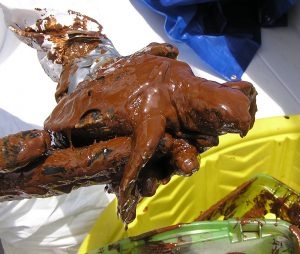30 October 2017
Plain language supports science communication
Posted by Shane Hanlon

Rescued sea turtle covered in Deepwater Horizon oil in 2010 (NOAA photo by T. Hirama, Florida Fish and Wildlife Conservation Commission)
By Kate Goggin. This post was originally published by the Center for Plain Language.
I love helping scientists translate tech talk into plain language. Often the editing process goes smoothly, but sometimes, they have reservations. The fears I hear most often involve dumbing down the information, or, oversimplifying it. “Those are common complaints,” says Dr. Lisa DiPinto, Senior Scientist at the National Oceanographic and Atmospheric Administration, and one of my colleagues, in the Office of Response and Restoration. “Scientists have legitimate concerns about plain language editing. Will some important detail get lost in translation, or get left out?”
Communicating science to the public
Luckily, Dr. DiPinto embraces plain language writing and editing, and she believes it helps connect the public to science. “That is a core value that was instilled in me by my professors. I am in the applied science field, and we’ve got to be able to communicate outside of academic circles. It is always on my agenda, even when I am planning a project from the beginning.”
Her projects require a lot of public attention. For example, she was the chief scientist who investigated the environmental damage caused by the 2010 Deepwater Horizon oil spill. Noted as the largest offshore oil spill in U.S. history, she led a scientific team that:
- made more than 20,000 trips to the field
- obtained over 100,000 environmental samples
- and therefore, created more than 15 million records.
The massive data collection, and subsequent series of scientific studies, documented the largest natural resources damage assessment ever conducted. The resulting report, titled, the Final Programmatic Damage Assessment and Restoration Plan and Final Programmatic Environmental Impact Statement, formed the basis of the Nation’s largest civil settlement — $8.8 billion — reached with BP America.
A Mountain of Facts
To achieve these historic milestones, that report had to be scientifically sound and legally defensible. The document spanned 1,659 pages and weighed approximately 15 pounds. While it is possible someone actually read every page, chances are better that people actually read the plain language overview instead.
An army of scientists and an army of editing staff from Eastern Research Group, Inc. created the 54-page overview. “We knew we had to communicate our findings to the public, lawyers, and judges, so it quickly became a valuable tool,” said Dr. DiPinto.
Some of the plain language methods employed include use of headings and subheadings, active voice, lists, and tables. Additionally, they inserted compelling photos, infographics, and call out boxes to convey information and to break up the text. Another effective technique incorporated the use of concrete familiar words, especially when describing the scope and scale of the spill.
Deepwater Horizon by the numbers
- 3.19 million barrels (134 million gallons) of oil released into the ocean.
- 15,300 square miles: the maximum extent of the oil slick on a single day (June 19, 2010)—an area 10 times the size of Rhode Island.
- 43,300 square miles: cumulative extent of the surface slick during the course of the spill—an area approximately equal to the size of Virginia.
- At least 1,300 miles of shoreline fouled by oil—more than the distance by road from New Orleans to New York City.
Restoration of the Gulf is an ongoing process, so the document is widely distributed at public meetings, and it also provides valuable context for the media who still devote a lot of time to this story.
Since I arrived at NOAA after the incident, I consider it my Bible for Deepwater Horizon information. I reference it daily, and it makes a great case study when convincing reluctant scientists to use plain language techniques.
Disclaimer: The contents of this blog are mine personally and do not necessarily reflect any position of NOAA.
–Kate Goggin is an Environmental Communications Specialist for NOAA’s Office of Response and Restoration. She has worked in outreach and public affairs for several federal agencies including the U.S. State Department and the Bureau of Reclamation at the U.S. Department of the Interior. She holds a degree in Communications Consulting from George Mason University and currently serves as a media liaison with the NOAA Communications Office.










 The Plainspoken Scientist is the science communication blog of AGU’s Sharing Science program. With this blog, we wish to showcase creative and effective science communication via multiple mediums and modes.
The Plainspoken Scientist is the science communication blog of AGU’s Sharing Science program. With this blog, we wish to showcase creative and effective science communication via multiple mediums and modes.